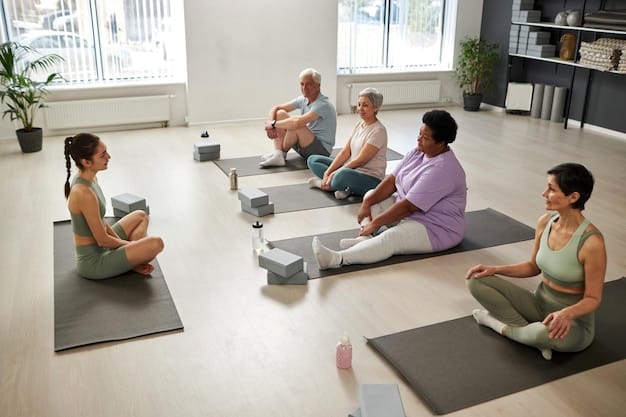Updated CDC Exercise Guidelines: Are You Meeting the Recommendations?

The updated CDC guidelines for daily exercise recommend adults engage in at least 150 minutes of moderate-intensity or 75 minutes of vigorous-intensity aerobic activity per week, along with muscle-strengthening activities on two or more days.
Are you getting enough exercise each day? The updated CDC guidelines for daily exercise: Are You Meeting the New Recommendations? These guidelines have been updated to reflect the latest research on the benefits of physical activity, emphasizing the importance of regular movement for overall health and well-being.
Understanding the CDC’s Updated Exercise Recommendations
The Centers for Disease Control and Prevention (CDC) provides recommendations to help individuals lead healthier lives. When it comes to physical activity, understanding these guidelines is crucial. The CDC emphasizes that any amount of physical activity is better than none, but to achieve substantial health benefits, adults should aim for specific targets.
These guidelines are based on extensive research demonstrating the numerous benefits of regular physical activity on various health outcomes, including cardiovascular health, weight management, and mental well-being. Let’s dive into the specifics of these recommendations.
Key Components of the Guidelines
The CDC’s updated exercise guidelines focus on two main types of physical activity: aerobic exercise and muscle-strengthening activities. Both are essential for maintaining optimal health.
- Aerobic Exercise: This involves activities that make you breathe harder and your heart beat faster, such as walking, running, swimming, and cycling.
- Muscle-Strengthening Activities: These activities work all the major muscle groups of your body (legs, hips, back, chest, abdomen, shoulders, and arms). Examples include lifting weights, using resistance bands, and doing bodyweight exercises like push-ups and squats.
- Flexibility and Balance: While not explicitly emphasized as much as aerobic and muscle-strengthening activities, flexibility and balance exercises, such as yoga and tai chi, are also beneficial for overall health and mobility.

In summary, the CDC recommends incorporating a mix of aerobic and muscle-strengthening activities into your weekly routine to maximize health benefits.
Aerobic Exercise: How Much is Enough?
Aerobic exercise is a cornerstone of the CDC’s physical activity recommendations. Understanding the intensity and duration required can empower you to tailor your workouts to meet these guidelines effectively.
The key is to find activities you enjoy and can sustain over time, making it easier to incorporate regular exercise into your lifestyle.
Moderate-Intensity vs. Vigorous-Intensity
Aerobic exercise is categorized into moderate and vigorous intensities. The intensity level affects the duration needed to achieve the recommended amount of physical activity.
- Moderate-Intensity: Activities like brisk walking, cycling at a leisurely pace, or gardening. You should be able to talk, but not sing, during the activity.
- Vigorous-Intensity: Activities like running, swimming laps, or hiking uphill. You likely won’t be able to say more than a few words without pausing for a breath.
- Meeting the Guidelines: Adults should aim for at least 150 minutes of moderate-intensity or 75 minutes of vigorous-intensity aerobic activity per week. A combination of both is also acceptable.
For example, you could aim for 30 minutes of brisk walking five days a week to meet the moderate-intensity recommendation, or opt for 25 minutes of running three days a week to fulfill the vigorous-intensity requirement. A mix of both is also a great approach.
Strength Training: Building a Stronger You
Muscle-strengthening activities are an integral part of the CDC’s exercise guidelines, focusing on building and maintaining muscle mass. These activities help improve bone density, enhance metabolism, and increase overall strength and endurance.
Incorporating strength training into your routine can have profound effects, including reducing the risk of falls, improving posture, and boosting your ability to perform daily tasks.

Effective Strength Training Exercises
Strength training doesn’t require expensive gym equipment. Many effective exercises can be done at home using your body weight or simple resistance tools.
- Bodyweight Exercises: Push-ups, squats, lunges, and planks are great options that require no equipment.
- Resistance Bands: These versatile tools offer varying levels of resistance and are easy to store.
- Weightlifting: Using dumbbells or barbells can effectively target all major muscle groups.
Remember to focus on proper form to prevent injuries. Consider consulting a fitness professional for guidance, especially if you are new to strength training.
Practical Ways to Incorporate Exercise into Your Daily Routine
Integrating the CDC’s exercise guidelines into your daily life doesn’t have to be daunting. By making small, incremental changes, you can gradually increase your activity levels and reap the numerous health benefits.
The key is to find activities you enjoy and can realistically fit into your schedule. Consistency is more important than intensity, particularly when starting out.
Simple Strategies for Staying Active
Here are some actionable tips to incorporate more physical activity into your daily routine:
Walk or bike for short commutes instead of driving. Use the stairs instead of the elevator. Take active breaks during work. Participate in recreational sports or activities you enjoy. Make exercise a social activity.
By adopting these strategies, you can transform mundane tasks into opportunities for physical activity.
Consistency is key. Even short bursts of activity throughout the day can add up and contribute to meeting the CDC’s recommendations.
Overcoming Barriers to Physical Activity
Many people face challenges that make it difficult to meet the CDC’s exercise guidelines. Common barriers include lack of time, lack of access to facilities, and health conditions. Addressing these barriers is crucial for improving overall physical activity levels.
Identifying your personal challenges is the first step toward developing strategies to overcome them and make regular exercise a sustainable part of your life.
Strategies to Overcome Challenges
Here are some practical strategies to help you overcome common barriers to physical activity:
Create a realistic schedule. Find affordable or free exercise options. Adapt activities to accommodate health conditions. Use technology to stay motivated. Seek support from friends, family, or a healthcare provider.
Remember, small steps can lead to significant improvements. Start where you are, and gradually increase the intensity and duration of your activities as you become more comfortable.
By identifying and addressing your specific barriers, you can pave the way for a more active and healthier lifestyle.
The Benefits of Meeting the CDC Guidelines
Meeting the CDC’s exercise guidelines offers a multitude of benefits that extend far beyond physical health. Regular physical activity can improve your mental well-being, boost your energy levels, and enhance your overall quality of life.
Understanding these benefits can serve as a powerful motivator to prioritize exercise and make it a consistent part of your routine.
Improved Health and Well-being
Here are some of the key benefits of meeting the CDC’s exercise guidelines:
- Reduced Risk of Chronic Diseases: Regular physical activity can lower your risk of heart disease, stroke, type 2 diabetes, and certain types of cancer.
- Weight Management: Exercise helps burn calories and maintain a healthy weight, reducing the risk of obesity-related health problems.
- Improved Mental Health: Physical activity can alleviate symptoms of anxiety and depression, boost mood, and improve cognitive function.
- Enhanced Bone and Muscle Strength: Weight-bearing and muscle-strengthening activities can improve bone density and prevent age-related muscle loss.
In conclusion, adhering to the CDC’s exercise guidelines can significantly improve your physical and mental health.
| Key Point | Brief Description |
|---|---|
| 🏃♀️ Aerobic Exercise | Aim for 150 minutes of moderate or 75 minutes of vigorous activity per week. |
| 💪 Strength Training | Include muscle-strengthening activities at least two days a week. |
| ⏱️ Consistency | Regular activity is key, even small amounts can make a difference. |
| 🧘 Overcoming Barriers | Find solutions for time constraints and access issues. |
Frequently Asked Questions
▼
Moderate-intensity activities are those that noticeably increase your heart rate and breathing. Examples include brisk walking, cycling on level ground, and active gardening.
▼
The CDC recommends incorporating muscle-strengthening activities that work all major muscle groups on at least two days per week. Allow for rest between sessions.
▼
Yes, a combination of moderate and vigorous activities can meet the guidelines. Remember that vigorous-intensity activities count twice as much as moderate ones.
▼
Any amount of physical activity is better than none. Start where you are and gradually increase the duration and intensity as you become more comfortable and conditioned.
▼
It is always a good idea to consult with your healthcare provider before starting a new exercise program, especially if you have any underlying health conditions or concerns.
Conclusion
Understanding and adhering to the updated CDC guidelines for daily exercise is a crucial step toward improving overall health and well-being. By incorporating regular aerobic and muscle-strengthening activities into your routine, you can reduce your risk of chronic diseases, manage your weight, enhance your mental health, and boost your energy levels. Remember, any amount of physical activity is beneficial, so start where you are and gradually work towards meeting the recommended targets.





